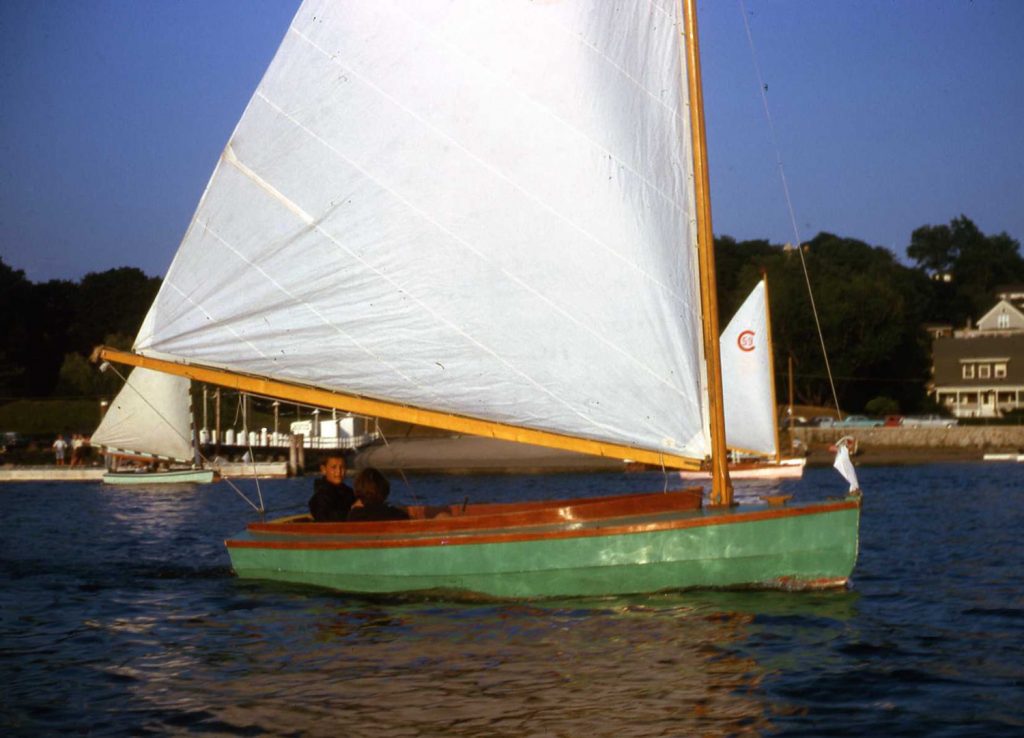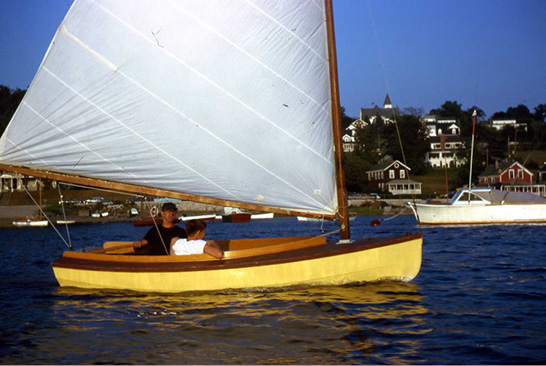By Gail M. Martin
Editor’s note: You’ll find the first part of Gail’s article at windcheckmagazine.com/article/the-allure-of-the-candy-class/

T. Elton Wood designed the Candy to attract young people to the new sport of sailing.
The 13 ½-foot Candy class sailboats, first introduced in 1922, were popular sailing and racing boats for Narragansett Bay sailors until the 1970s. Designed by T. Elton Wood in 1921, the much-loved Marconi-rigged, easy-to-sail catboats’ popularity grew rapidly through the 1920s and so did their numbers. By 1930, there were twenty boats in the fleet, and over the next twenty years these numbers increased to a total of fifty-seven. Three more wooden Candies were built in the mid-1960s, bringing the total of wooden Candies to sixty.
It is fair to say that the 1950s and ‘60s were the golden years of Candy boat racing. The majority of Candy boats were home-ported in Tiverton, RI, with owners from Tiverton and Portsmouth, as well as Westport and Fall River, MA and other places. The tie that bound them together was the Tiverton Yacht Club (TYC), the family-friendly yacht club situated on the Tiverton Basin, which sponsored activities for both young and old members.
Following the traditions of the former Fall River Yacht Club, Tiverton Station, which was destroyed by the 1938 hurricane, the new TYC (incorporated in 1955), hosted not only sailing and racing, but also social activities and athletic activities such as swimming and diving. And, also like the former FRYC, the new clubhouse had large verandas from which members could view the races. During the 1960s, the TYC Candy fleet ranged in number generally in the thirties with a high of thirty-nine boats in 1963. However, in the 1970s, with 420s and Sunfish increasing rapidly in popularity, the Candiess enjoyed only a year or two more as an active racing fleet.

Candy #7 Life Saver
T. Elton Wood and his brother Commander Clarence E. Wood (USN- ret.) were great promoters of the class – T. Elton built twelve during the 1920s, while Clarence built an additional two. They were so anxious for the Candy fleet to grow that they practically gave the plans away for free. During the 1940s, other builders began to build Candies, and, as the boats aged, rebuilding had to take place. Consequently, even more builders became involved. It was all for the good of the fleet, as the new young skippers could buy used boats as other families “outgrew” them. Some Candy skippers moved on to larger boats such as the Indian class, but a good many just traded their older boat in for a newer model.
Because of the many builders, the uniformity of the boats was questionable and an endless source of ‘talk.’ Some boats seemed faster in light air or at certain points of sail. In fact, this caused some of the skippers previously mentioned to sell their boats in favor of new, and presumably faster, models. By the 1960s, some newer boats were racing against boats that were forty years older. Once a year, a ‘skippership’ race was held where every sailor sailed every boat in a two-day series. This race was held in hopes of putting to rest the lore of ‘builder advantage.’
By 1947, a group decided that perhaps more oversight was needed to keep the Candy fleet in conformity to the building specifications. A meeting to hash out these issues was held with T. Elton and officers of the club. They decided that all future Candies must conform to class specifications, and the inactive Candy Boat Association was once again formed. The measurement committee would have three members: T. Elton Wood, Thomas Toolin (later chairman of the TYC race committee), and one other member. It was agreed to accept all the existing boats into the class, but there would be an authorized builder, Harry Towne, who would build the next thirty boats. Mr. Towne employed T. Elton Wood at his boatyard in Tiverton to oversee construction of the Candies. The last three would be built by Henry Shorrocks in the 1960s.
There were lots of unique qualities of Candy boats – not the least of which were that they were named after popular candies of the era and sported colorful hulls. There was also the fact that the designer and his brother as well as other adults loved sailing and racing them. Imagine the excitement of 11-year-old Jim Nannery in the 1950s when he beat Clarence Wood (by then in his eighties) in a race! The adults were banned from racing in the 1920s, but gradually adults racing with the youngsters became an accepted practice in the Candy fleet.
Like the Beetle class, Candies competed in the Narragansett Bay Yachting Association (NBYA) regattas in two separate divisions, Class A (experienced sailors) and Class B (less experienced). Class B boats in the Candies were required to have a white triangular flag on the forestay. Candy skippers would organize amongst themselves to leave as a group on Friday before an NBYA regatta – timing their journey to use a favorable tide to get out of the basin and through the railroad bridge. Getting to a club like Newport Yacht Club would take approximately seven hours. Each sailor would leave their boat anchored, get a ride home, and return the next day and the day after to race. Sunday night, after all races were over, there was generally a tow line behind a member’s large cabin cruiser to get the fleet home. This was repeated several times over the course of the summer.

Each named for a confectionary treat, Candies were colorful.
Besides the NBYA regattas, highlights of the Candy class racing season were the evening racing series, and the special races held for a number of perpetual trophies. These trophies included the Wood Brothers Trophy, Jacob Ziskind Memorial Trophy, Sakonnet Sportsman Club Trophy, Stewart Grinnell Memorial Trophy, Nicolas Aguiar Memorial Trophy, and Barkers Insurance Agency Trophy, and of course the Class A and Class B club championship trophies of the Tiverton Yacht Club for each season.
In the 1990s, an active TYC member and former Candy sailor Duke McCann formed a group to complete an oral history of the Candy class. Working with him was another former Candy sailor, John Martin, who organized a series of forums for people to share memories of their Candy sailing years. People who could not attend sent in their written reflections. This effort was produced with a grant secured by the Tiverton Library and resulted in a volume still held at the library entitled Candy Boat Memories. Contained therein besides the personal essays are newspaper clippings and photographs – a valuable record of the years when Candies sailed the local waters.
Eventually the Wood family approved the production of a fiberglass Candy boat and nine were built. One fiberglass boat is still sailing in local waters. The Toolin family donated another fiberglass Candy, Nonpareil, to the Mystic Seaport Museum after Richard Toolin (Tom’s son) passed away after starting to make it seaworthy again. Lollypop (#1, a wooden boat) was also donated by Charles Flanagan to the Museum and is to be exhibited in their new Wells Exhibition Hall, to be opened possibly late this year. It is altogether appropriate that Lollypop and Nonpareil will show the world what a sweet boat the Candy was and serve as reminders of the great memories that were created by giving young and old alike a chance to sail and race in a boat that truly was one of a kind. ■
Gail M. Martin is a Candy Boat historian. To find out more about her books, go to newenglandmaritimepublications.weebly.com.

